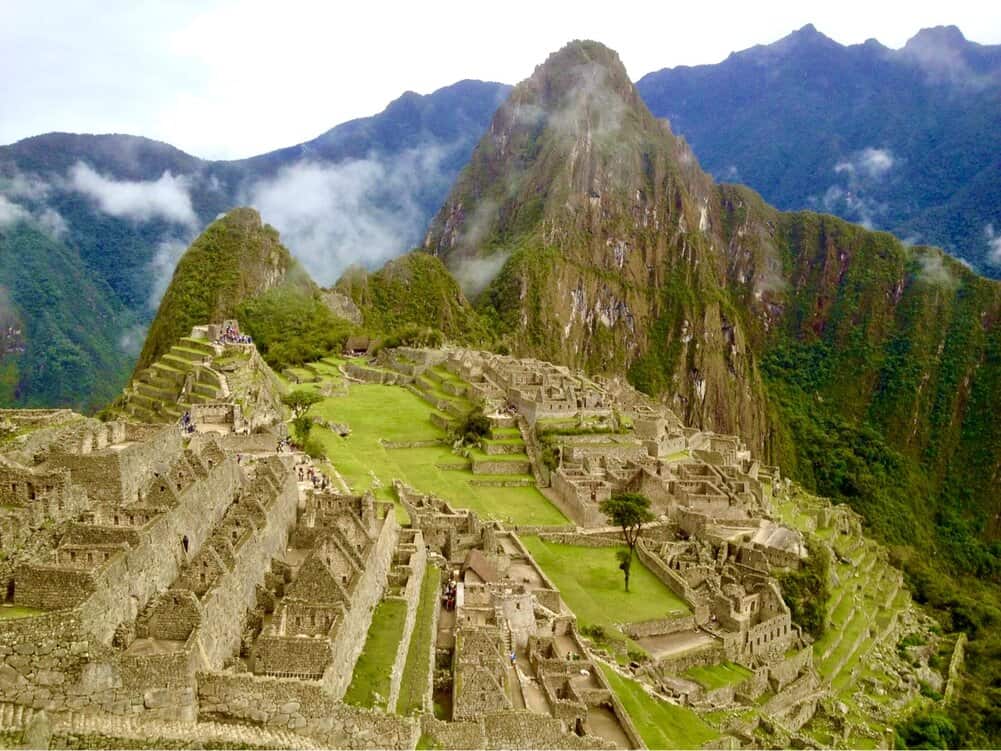The Inca Trail trek to Machu Picchu is one of the world’s great multi-day hikes. On this page we will fully prepare you for the trek, including how to book it, how to train for it, and what to expect when you get out onto the trail.
Covering about 26 miles (41.6 km) over three and a half days through the Peruvian Andes, the trail follows the ancient path of the Incas, who called the region home for hundreds of years. The climax of the hike is arriving at Machu Picchu, one of the most magical ancient cultural sites in the world, nestled in the mountains in all its glory.
It’s possible to visit Machu Picchu without doing the trek, but hiking really gets you a better sense of Incan culture. I completed the trek in 2012 and it was probably the most rewarding experience of my life up until that point. So read on to have an amazing hike along the Inca Trail in Peru!
Note: this article contains affiliate links, which means that should you purchase something or get a quote through them I may make a small commission at no additional cost to you. This helps keep the site running with up to date information. I do not represent World Nomads, GetYourGuide, or Booking.com. This is information only and not a recommendation to buy the product mentioned in this article.
The Inca Trail Trek – What You Need to Know
Where is Machu Picchu and the Inca Trail?
Machu Picchu is in the Andes Mountains of southern Peru. The closest major city is Cusco. The Inca Trail hike starts from a dead end in a small road known as KM 82, where your tour operator will drop you off at.
How to get there
To make the Inca Trail trek to Machu Picchu you’ll have to get to Cusco, Peru. Which means unless you’re taking a bus or driving around South America you’ll have to fly to Lima, the capital of Peru and take the short flight to Cusco from there.
Lima is well connected to the rest of the world and there are direct flights from many US and European cities. The hopper flights to Cusco run almost continuously and are pretty cheap. It will probably be cheaper to book an international flight to Lima and a separate ticket to Cusco. Just make sure to allow plenty of time to layover.
If you’re coming from Chile or Bolivia there are flights from Santiago and La Paz as well to Cusco too. From Cusco, transportation to the start of the trail will be handled by your tour company, so you won’t need to worry about that.
Weather and when to do the trek
Being so close to the equator, the temperature along the Inca Trail doesn’t vary by much year round. It varies mainly with elevation instead. The weather in this part of Peru is characterized by the wet season and the dry season.
The wet season runs from November to March. Rain can happen any time in the Andes, but it rains much more in the summer (Peru is in the Southern Hemisphere). The rainiest month is January.

For the highest chances of clear skies, the best time to visit Machu Picchu is the dry season, April to October. The number of hikers on the trail is regulated by the Peruvian government so it’s not like any particular month will be more busy than another.
I went in November at the start of the rainy season and it did rain quite a bit, though usually in the afternoon. So it’s not like summer will be miserable or anything. Also note that the trail is closed each February for maintenance. You can still visit Machu Picchu in February but you can’t do the trek.
Trail regulation
Whatever your thoughts are on government regulations, we should all agree that regulating the amount of people on the Inca Trail every day is a good thing. The trail is paved with stone, built hundreds of years ago by the ancient Incans. It’s a fragile environment, so the Peruvian government limits the number of people that can be on the trail at any given time.
500 trekkers – plus maybe 750 porters and guides – are allowed to start the trek each day. Your tour company will arrange your permit to use the trail. You cannot just go out to the Inca Trail and walk on it. If you don’t have a permit, you won’t be allowed past the checkpoint. And to get a permit you need to go with a guide. More on that later.
Where to stay before and after the trek
On the trek itself you’ll be camping and it will all be organized by your tour provider. But before and after the hike you’ll be staying in Cusco, as the tours start and end there. Lodging in Cusco is not part of the tour and you will be required to secure your own accommodation.
In order to acclimatize to the high altitude of the Andes, your tour operator will require you to arrive at least 2 nights prior to when you start hiking. Cusco sits at 11,200 ft (3400m) above sea level, making it the ideal place for your body to adjust to the elevation.
You’ll also get back to Cusco pretty late on the last day of the tour, so you’ll likely want to spend at least one night in Cusco at the end too. There are hundreds of lodging options in Cusco, from budget hostels to high end luxury hotels.
For true Peruvian hospitality stay at Antigua Casona San Blas. Or if that’s a bit out of the budget Amaru Colonial is an excellent affordable option in Cusco. You can also check out the full listing of properties on booking.com here.
There are also a ton of hostels in Cusco, which might be attractive due to their price. A word of warning, however: my friend got robbed at the hostel we stayed at in Cusco. The chances of that happening to you is slim, but it’s always a risk when staying in shared dorms in an impoverished nation.
Language
Spanish is spoken in Peru. Knowing some Spanish will be a huge plus on your trip, though you won’t need it when actually on the trek. The trekking guides all speak English.
Your porters will likely not speak a word of English, however, nor will many hospitality workers in Cusco. Even the tourist police in Cusco didn’t speak any English. You’d think the “tourist police” would be required to speak at least some English, right? Think again!
So in summary, you don’t need to know Spanish, but it’s a bonus.
Money
While everything is provided for you on the trek, it’s good to have some cash in case you want to buy drinks, snacks, or souvenirs from the locals who seek stuff along the Inca Trail. They don’t accept credit cards.
The currency in Peru is the Sol, and if you’re coming from a western nation the exchange rate will be favorable to you. Be sure to take out cash before you leave Cusco, as there will be no ATMs once you’ve left the city.
Travel Insurance
While the tour companies don’t require you to have travel insurance, it’s a really good idea for a trip like this. We use World Nomads when we travel internationally. Word Nomads provides coverage to travelers in over 100 countries. You can search for a coverage plan using the link below.
Preparing for the Inca Trail Trek
The Inca Trail is not a walk in the park. I mean, technically it is, but this is no easy feat. You’ll be hiking high in the Andes and gain nearly 10,000 ft (3050m) of elevation over the course of the hike. That being said, anyone can complete the hike with the right attitude and adequate preparation.
Physical preparation
Some basic level of fitness is required to complete the trek. It’s an intense multi-day trek high in the mountains, not a walk through the woods. It’s important to understand the difference between hiking and trekking so you’re not thrown off when you get out there.
You will be on your feet most of the day, climbing up and down stairs through the Andes Mountains. While porters carry your tents and sleeping bags and meals, any clothing and water/snacks you need over the course of the trek you will need to carry yourself. So add a moderately heavy backpack and those mountain stairs become pretty daunting.
That being said, a friend of mine who was pretty damn out of shape managed to finish it. She looked pretty miserable at the end of each day, but she made it.

I’d suggest a solid fitness plan in the months prior to the trek to prepare yourself to have the best time possible. This should include practice hikes – or walking on an inclined treadmill if you live somewhere flat – on top of basic cardio training like running and biking. The fitter you are, the more you’ll enjoy it.
The altitude can also be dangerous for people with a history of altitude sickness. If you’ve ever had altitude sickness or struggled with high altitudes before, this trek is not something you should consider.
If you’re worried about the altitude, talk to your doctor before booking. There are high altitude medications that can be taken. I was lucky enough not to need them but some people swear by them.
Logistical preparation
While the trek itself with the Machu Picchu visit is only 4 days, you’ll need at least 7 days in Peru to make this trip possible. As previously discussed, the tour agencies all require you to spend at least two nights in Cusco before you start hiking to acclimatize.
I also advise you to spend at least one night in Cusco after you complete the trek instead of trying to fly out late on the day you end the trek. It’s possible to do that but it’s pushing your luck.
There are plenty of other things to do around Cusco so spending some extra time in the city shouldn’t be seen as a bad thing. One of the most popular activities is to take a day trip to Rainbow Mountain, the famous colorful mountain in the Andes south of Cusco. It will be a long day and you’ll have to wait in line with other tourists for that famous photo.
There are tons of other amazing alpine regions around Cusco as well. Humantay Lake is one of the most beautiful places in Peru and it’s possible to make a day trip there as well. Cusco is also the starting point for many jungle tours through the Amazon in Manu National Park.
Another reason it’s a good idea to stay a night in Cusco at the end of the trek is because the hotels and hostels will store your bags/suitcases for you while you’re off on the trek. Whatever you don’t need while hiking can be securely kept at the hotel. Bring all your valuables, but leave anything you don’t want to carry on your back for four days.
Tourist Visas
Travelers from most western nations are allowed visa-free entry to Peru. This includes anyone from South America, North America, the EU countries, the UK, Australia, New Zealand, South Africa, and a few other countries. If you’re not from a country on this list, be sure to check your country’s requirements early on in planning your trip.
Packing for the trek
As we’ve already discussed, the weather is unpredictable in the Andes Mountains. You’ll need to come prepared for everything. Here is a packing list that should be sufficient.
- High quality rain jacket: don’t go cheap on your rain jacket, you need one that will keep you dry in pouring rain.
- Rain poncho: it’s a good idea to have some of these too.
- Gloves: both light and heavy (preferably touch screen).
- Beanie: it’s cold above 4000 meters.
- Sunscreen: a sunburn on the first day could make the rest of the trek painful.
- Sunglasses.
- Battery powered charger for your phone: There are very few places to charge your phone on the trail so you’ll have to prepare for not being able to charge it. If you use it for a camera like most people do these days, you’ll want a portable charger and I’d seriously consider bringing more than one.
- Extra battery for camera: if you are taking a DSL camera you’ll want an extra battery for that too.
- Multiple water bottles: You will get boiled water in the morning and that will have to last you all day unless you purchase bottled water from the villagers.
- Backpack: you’ll be carrying your own clothing on this trek. Tents and food will be carried by porters, but you’re responsible to carry your own belongings. Make sure to have a decent overnight backpack.
Booking the Inca Trail Trek
As mentioned before, the Inca Trail is regulated by the Peruvian government in order to protect and preserve it. You can’t just wake up in the morning and go hiking on it. You need permits and these permits are only available through certified trekking guides in Peru.
So if you’re looking for a cheap vacation this is not it. Going without a guide is not possible and you need to reserve your spot in a guided tour well in advance. Only 500 trekkers are allowed to start the Inca Trail every day, so advanced booking is paramount.
There are numerous agencies that offer the trek and everything can be booked online or through email. I went with a company called Peru Treks, who was awesome and I highly recommend them. There are tons of other great companies that offer the same experience, though.
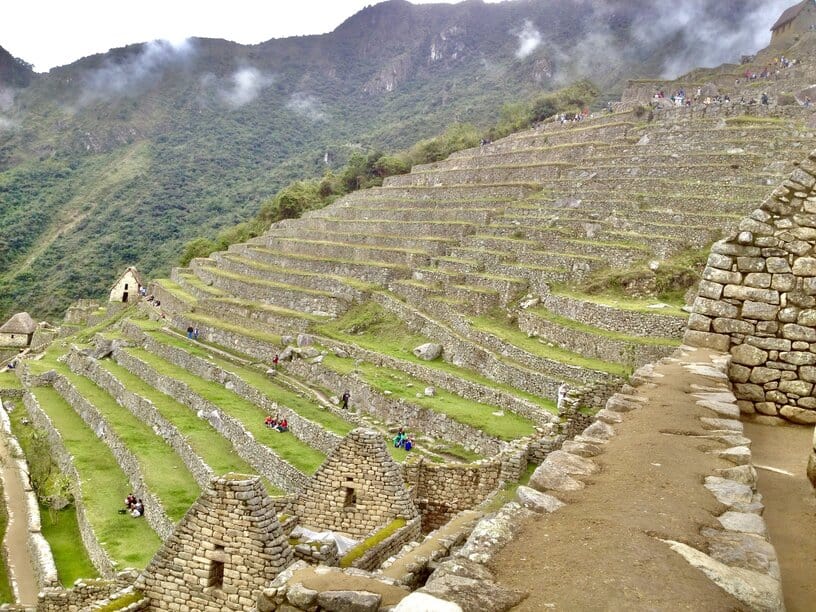
Trek cost
The cost of the trek has been rising steadily over the years and now sits between about $700-$800 per person, depending on the operator. This does not include accommodation in Cusco, but includes transport from and back to Cusco, as well as Inca Trail permits and all your food and services on the trail (but not alcohol). For what you get it’s actually not a bad deal.
Trip group size
Trip groups can be as small as just you if you want to pay for a private tour, or up to 20 or so trekkers. I was in a group of 16, including 4 friends of mine, and found it a perfect group size for comradery and motivation.
Food on the trek
All meals while on the trail will be provided for you. You’d think it would be simple hiking fare, but the food was exquisite. Our group had two chefs that cooked everything fresh for us, three meals a day. We had all sorts of typical Peruvian food like lomo saltado as well as standard international fare like pizza.
I found the quantity of food quite sufficient, but it’s still a good idea to carry some snacks, as you’re really burning a lot of calories out there and need to remain energized.
Accommodation on the trek
You will sleep in tents, two to a tent. The tents are large so you have room to stretch out away from your tent partner, whom you might not know personally. If camping isn’t your forte, then you’re probably better off skipping the trek and taking the train to Machu Picchu.
A Quick Word on Cusco
If you’re not spending time in Lima your trip will start and end in Cusco and the Sacred Valley. Cusco is as rich in Incan history as Machu Picchu itself is. Being forced to spend two nights here is not something you’ll be angry about.
A full discussion of Cusco is beyond the scope of this post, but there are tons of things to do in and around Cusco.
One thing I’ll say to definitely not miss, however, is Saqsaywaman. This is a large archaeological site of Incan ruins just at the edge of Cusco. You can walk there from central Cusco and wander the site for an hour or two before heading back into town. You also get a great view of the city and the surrounding valley from the site.

Saqsaywaman is mostly known for its large masonry structures that were built – amazingly – without any mortar. Giant blocks, all of different sizes, were fit perfectly together and stacked to form these structures that have withstood earthquakes and other natural disasters throughout the years. It’s truly fascinating!
I’ve mentioned day trips from Cusco previously, but there are also a ton of other additional things to do in Cusco itself. For inspiration, check out the options in Cusco on GetYourGuide.
An Overview of the Inca Trail Trek
Now let’s talk about what you’re gonna see and do on the trek itself. One thing you’ll be sure to see is beautiful mountain scenery all around. The Andes are some serious mountains. You might be higher than you’ve ever been before on the trail still looking up to snow-capped peaks in front of you.
The mountains here are simply stunning, and the ruins of ancient Incan cities haunt the landscape. That’s right: Machu Picchu is not the only attraction on the trail. The trail itself is loaded with ancient Incan archaeological sites you can explore.
The whole trek is just awesome. Check out the trail on AllTrails for a detailed map and elevation guide.
Trek Day 1
You’ll be awake well before the sun rises in Cusco to be picked up by your tour company. Our bus picked us up just before 6:00. The scenic ride through the mountains takes about two hours and you’ll probably stop for breakfast and to pick up your porters, who typically live in the mountain villages.
There’s a security checkpoint at the start of the trail (checking your permits and passports) and after that you’re off, racing up and down the mountains just like the ancient Incans.
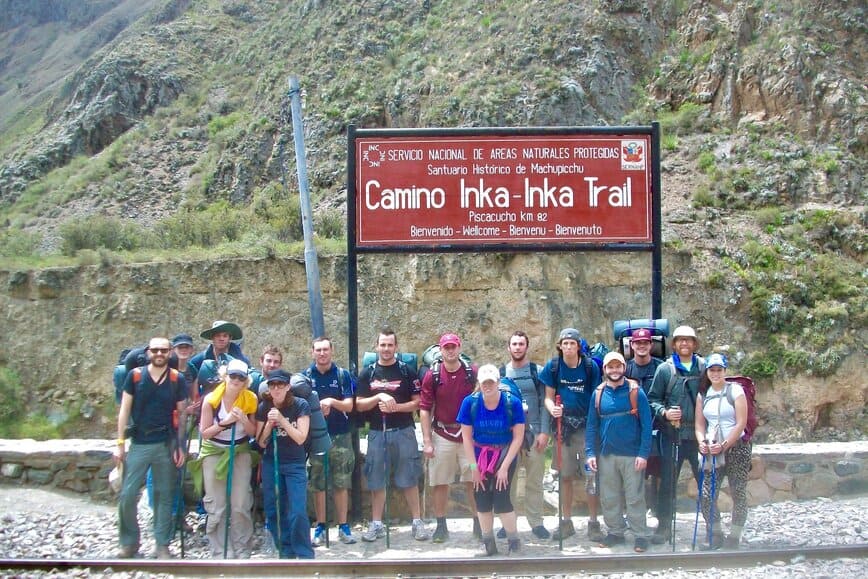
You’ll cover about 7.5 miles (12 km) on the first day, assuming your campsite is in Wayllabamba, where most tours stay the first night. It’s mostly an easy day, with a steady gradual climb of about 2,000 feet (600m).
The first day is really a warm up for day two. You’ll be in the valley the entire day, looking up to giant Andean peaks covered in snow. You’ll also see your first Incan ruin, Llactapata, on Day 1.
You won’t be able to walk around this site, as it’s on the other side of the river, but you’ll see it clearly from the trail. It’s a large series of terraces with some buildings atop a hill.

At the campsites on the trip you’ll find locals selling things like candy bars and beer and water, etc. So if you are hungry or thirsty you are not going to struggle. You’ll probably have sufficient time at the campsites to relax and explore if you want. Get to bed early though, because Day 2 is a beast.
Trek Day 2
The second day is the most difficult day on the Inca Trail. You’ll start your day around 6 AM. From the campsite you’ll head straight up all morning to Dead Woman’s Pass, the highest point on the trail at 4215m (13,828 ft).
It’s about 1200m (3900 ft) of elevation gain high in the Andes over a distance of barely 3 miles. Saying it is steep is an understatement. There is not a single portion of flat or downhill terrain until you get to the pass. It’s simply brutal.
If you’re ever gonna feel the altitude, it’s on Day 2. This is where your group will start to separate. If you haven’t adequately prepared for the trek, the morning will not be a whole lot of fun. But eventually everyone makes it to the pass, and the rest of the day is downhill.
At the time, Dead Woman’s Pass was the highest I had ever been. I’ve since hiked to Everest Base Camp and been higher in the US. But in complete contrast to the mountains in the US, up at 13,828 feet you are still well below the tree line in Peru, looking up to the peaks around you.
From the pass it’s straight downhill 2000 feet in elevation to the campsite at Pacaymayo. You only cover about 6 miles total on Day 2 but you can reasonably expect it to take about 6-7 hours if you’re in shape and considerably longer if you’re not.
We got to camp at about 1:00 PM and after lunch we had a free afternoon to rest and recover, which was vital after a backbreaking day on the trail.
Trek Day 3
The third day is the longest on the trail, nearly 10 miles, but it’s not nearly as difficult as Day 2. You start with an early morning climb though, back up about 13,000 feet, where you’ll pass the ruins of Runkuracay before heading back downhill. From here it’s mostly downhill all the way to Machu Picchu.
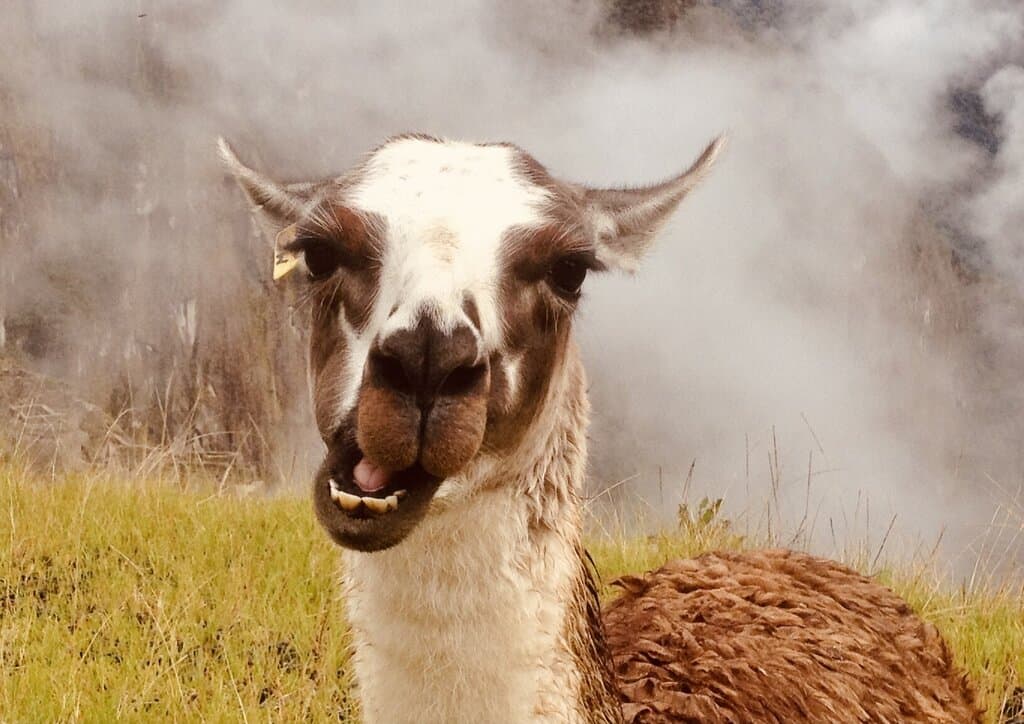
You’ll pass the ancient fortress of Sayacmarca before heading down to Phuyupatamarca, one of the most impressive Incan ruins on the trail. The trail goes right through the site so you can get up close and personal with it. You might see llamas roaming around, chomping away on grass.
I got stuck in rain for this portion of the trail, but hopefully you’ll have a nice day and can enjoy the amazing views as you head down to the campsite at Winay Wayna.
You’ll want to get to bed early tonight – your last night camping in the Andes – because you’ll be up super early tomorrow. And Machu Picchu awaits!
Trek Day 4
Today’s hike is short, but you’ll be awoken horribly early, like prior to 4 AM early, so you can get onto the trail and pass through the gates to Machu Picchu as soon as possible. The earlier you get there, the more time you have at the site. Waking up early is not that big of a deal when the reward is Machu friking Picchu!
Your guide will tell you that you’re getting up early to get a head start toward Machu Picchu. But the truth is that every other group is getting up at the same time or earlier. We still had to wait an hour at the entrance to Machu Picchu (they check permits again).
Just after the checkpoint you’ll get your first view of the ancient Incan city. I was blown away at first sight of Machu Picchu. You see it in pictures but don’t realize just how massive it is until it’s right in front of you. It’s an incredibly impressive site to behold.
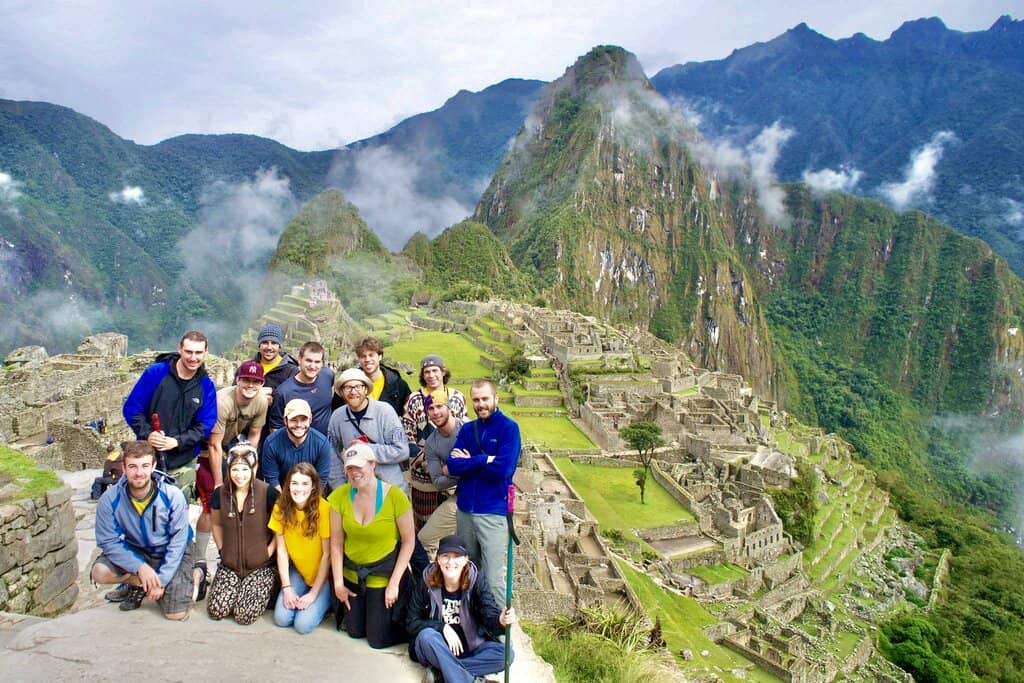
A few minutes later you’ll be standing right in front of Machu Picchu, one of the most iconic places in the entire world. You’ve endured a hell of a hike to get here, but it’s all worth it now!
Machu Picchu and the End of the Trek
You’ll only have a few hours to roam Machu Picchu. As I said, it’s a huge site, so there is a lot to see and a lot of paths to turn down. Your guide will also offer a tour of the site if you wish to join. Might as well learn about the history of Machu Picchu while you’re there. You’ll still have time to explore on your own after the tour is over.
One thing you’ll learn is that the reason the ancient site is in such great shape is because the Spanish conquerors never found it to destroy. It simply sat for centuries while nature took its course. It was “discovered” only in 1911 and beautifully excavated and restored to its original majesty.
These days it’s solely a site for tourists. And you’ll see plenty of them here. While the Inca Trail has a strict capacity limit, it seems like everyone and their uncle is at Machu Picchu.
The vast majority of visitors to Machu Picchu don’t do the hike, but take the train and/or a bus to the site. You’ll see thousands of tourists from all over the world as you wander the site.
Climbing Huayna Picchu
That steep peak in the background of every Machu Picchu photo you’ve ever seen is Huayna Picchu. If you’d like to hike to the top you’ll need a permit. As with the Inca Trail, there is a strict limit for how many people can climb Huayna Picchu each day (about 400).
Your tour company can arrange the permit, but you’ll need to decide if you want to hike it ahead of time. No game time decisions here. I didn’t do the hike, nor did anyone else in my group.
It’s not a long hike, but it will take about 40-60 minutes to get to the peak, depending on your fitness level. It’s an incredibly steep trail straight up ancient stairs.
You’ll get some different views from the top, Machu Picchu from the other direction. It will take away from your time wandering the site though. I assumed I wouldn’t want to hike any more after 3 days of intense hiking through the Andres. But if I return to Machu Picchu one day I think I’ll do the hike to the peak.
Machu Picchu without the Inca Trail Trek
This post is about the Inca Trail Trek so I’ve focused on that, but most people visit Machu Picchu without the hike. If after reading through all of this you think the trek might be too much for you, then you’ll have to take the train from Cusco to Aguas Caliente, a little village in the mountains with no cars. Be sure to book your train well in advance though, as they sell out.
I won’t go through the details on how to get to Machu Picchu but there is ample info online about it. To enter Machu Picchu you’ll need to book ahead of time and go with a guide (you can hire one on site if you wish). Check out this website for further information.
The Lares Trek
Want to hike to Machu Picchu but the Inca Trail is already sold out? Then you might want to consider the Lares Trek.
While the trail itself doesn’t exactly take you to Machu Picchu (you’ll take a bus to Aguas Caliente from the end of the trail), you’ll still get to trek three days through the Andes. And the bonus of the Lares Trek is that it’s far less crowded. A guide is still needed and it will cost almost as much as the Inca Trail.
It’s actually a more strenuous trek. It’s longer and you’ll go far higher in elevation, up to about 15,420 feet (4700m). I might consider doing this trek at some point in the future!
Inca Trail Trek – Frequently Asked Questions
Can a beginner hike the Inca Trail?
Anyone can hike the Inca Trail, but the fitter you are the more you will enjoy the experience. If you are overweight and out of shape you will really struggle, but if you have the determination then you will make it, slowly but surely. The biggest thing to consider is the elevation – up to 4215m (13,828 ft) – which many people struggle with.
Where do you sleep on the Inca Trail?
On the trek you sleep in tents that are set up by the porters. There are no hotels or anything like that. Tents are also shared, so get cozy!
Do you shower on the Inca Trail?
No, there are no showers along the Inca Trail. If you’re someone who needs a shower every morning to get going then you’re gonna struggle here. You will stink after all the trekking, but that shower when you get back to Cusco will surely be sweet!
How do you use the toilet on the Inca Trail?
There are outhouse style toilets every so often along the Inca Trail. These are squat toilets that are not the most comfortable way to go to the bathroom, but it’s better than going in the rocks.
What is the hardest day of the Inca Trail?
The second day is the toughest day on the Inca Trail. While it’s the shortest day in terms of distance traveled, it has a serious elevation gain and reaches the highest point you’ll get to on the trek at 4215m (13,828 ft).
Final Word
The Inca Trail Trek to Machu Picchu is an epic multi-day hike through the Andes Mountains that takes you to one of the most famous archaeological sites in the world.
You’ll eat great food and make new friends as you trek up and down the mountains, giant snow capped peaks and ancient Incan villages all around you. It’s a very rewarding experience and I’m sure you’ll love it as much as I did!

